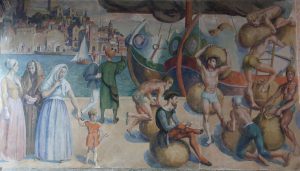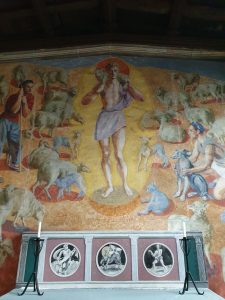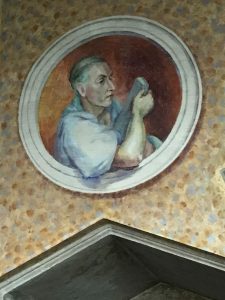By Joshua Sewell (volunteer in the University Library)
Lincoln Cathedral holds a lot of history for a structure composed mostly of stone and glass, a history that goes back nearly a thousand years. Once the tallest structure in the world and formerly one of the resting places of an original copy of the Magna Carta, the building is no stranger to events and possessions of historical importance. But those stories have been told forever and evermore. What we want to find are those tales that are less well known, but still of high value. One such tale finds its home in the Russell Chantry area of the Cathedral, and its events took place not so long ago. Inside the Chantry can be found a set of murals that adorn the walls and hold a significance that many may not be aware of. The murals have been open to public viewing since 1990, but their existence predates this by more than 3 decades. Here a question of great interest presents itself, why were the murals hidden from public view for all that time?
To begin we need to go back to the 1950s, 1952 to be exact, when a notice placed in The Times by the Edwin Austin Memorial Fund invited proposals for murals to be created for important religious buildings. One of these notices happened to end up in the hands of famed painter Duncan Grant (1885-1978).(1) Grant was a member of the famous (and at times, infamous) Bloomsbury group of artists. Grant was chosen to create a mural to be placed in the Russell Chantry of the Lincoln Cathedral. It was decided that the mural would be based around St Blaise, the patron saint of the wool industry, due to Lincoln’s history as a one of the principal towns in which wool was collected and taxed during the medieval period.(2)

Grant began creating the murals in 1956 and started work with a few different ideas for what he wanted the murals to be. In a note that can be found in Watney’s The Art of Duncan Grant, Grant states that “There the opportunity would most likely have been taken to paint with all possible horror the frightful death of St. Blaise, torn to pieces by the combs of the wool workers.”(3) Grant ultimately decided against creating such a gruesome scene (probably for the best) and instead decided to create a mural that would better reflect the city of Lincoln. On one wall he would portray dock workers on the Brayford with the city of Lincoln and the Cathedral present in the background.
(1) Frances Spalding, Duncan Grant: A Bibliography (London: Chatto and Windus, 1997), p.418.
(2) Edward Mayor, The Duncan Grant Murals in Lincoln Cathedral (Lincoln: Lincoln Cathedral Publications, 2001), P.42.
(3) Simon Watney, The Art of Duncan Grant (London, John Murray, 1990), P.88.
Whilst this piece of the mural may seem quite innocuous to the everyday observer, the murals became the cause of quite a stir when they were originally revealed. However, this part of the murals was not to be the primary cause of the controversy, but instead it was the mural that could be found displayed on the opposing wall that would draw most of the attention. On the opposing wall could be found a mural portraying the Good Shepherd Jesus Christ being watched by shepherds tending to their sheep as he passes.

Whilst to most this mural would appear to simply be an innocent and purely devoted painting in reverence to Jesus, for a small few it came to be seen as a mockery of Christianity and of the Cathedral. According to Mayor, when the murals were finished in 1958 and shown to the Dean and his chapter, they initially expressed themselves ‘delighted’ with the murals.(4) However, shortly after the unveiling of the murals in 1959, the chapel was closed with the murals being kept hidden from the public. To find that the murals would be locked away in secret after this initial positive reception would baffle anyone. If they were delighted with the murals, why would they lock them away out of sight of the public? It is at this point that the story of the murals would take a turn for the worse. Whilst the reception to the murals initially appeared to be positive, there was a small few who took exception to certain elements of the murals and to the artist himself. There were concerns over the near nudity of the dock workers on the Brayford, as well as the depiction of a younger, beardless Christ than what is normally depicted in tradition. Some accused Grant of featuring homo-erotic elements in his work and it is these accusations that would be used by a minority to confirm some of the issues that they may have had with Grant himself, Grant’s rumoured homosexuality. Mayor stated that ‘the general public would not know about the unconventional lives and loves of the Bloomsbury survivors until the Sunday Times published extracts from Michael Holdroyd’s biography of Lytton Strachey in September 1967.’(5)
(4) Mayor, P.15
(5) Mayor, P.16
However, the rumours were in place well before this revelation and it is not difficult to believe that some members of the chapter may already have been made aware of the artist’s personal life well in advance. The accusations towards Grant and his murals were only made worse when it became known that for the choice of model for the portrayal of the Good Shepherd, Grant decided to use his close friend and most likely lover, Paul Roche. Some took offense to Grant’s portrayal of Christ, namely his youth and nakedness, stating that it lacked the solemness that is usually found in portrayals of Christ. They may have considered the Good Shepherd as too representative of the model himself and it is with these accusations that a myth was developed that would seal the fate of the murals behind a closed door for over three decades.

Above the entrance to the Russell Chantry lies a mural depicting St Blaise leaning out of a roundel and gazing towards the Good Shepherd. A myth circulates, even to this day, that the likeness depicted in the mural was the artist himself. Spalding states that this began when:
A certain Dean thought, wrongly, that Duncan had used his own likeness for the head of St.Blaize, who leans out of a roundel over the entrance door, and that his rapt gaze, directed towards the
Good Shepherd on the altar wall, expressed not contemplation of Christ but an elderly painter’s obsessive lust for his model.(6)
This was considered an embarrassment for the church and enough of a reason to condemn the murals into a state of non-existence. It is fair to say that the church has often had a rocky relationship when it comes to their views on homosexuality, and the story of the Lincoln Cathedral murals is another chapter in that long history. Duncan Grant’s murals were locked away because they were deemed to mix religion too closely with life, more importantly the life of a gay man. The chapel was forsaken and turned into a storeroom for the better part of thirty years all because of the irrational fear that a few had in allowing the work of a gay man to be displayed on their walls. The insinuations that the murals were merely a display for Grant’s supposed lust for his model were false as shown by Mayor when he states that ‘the saint’s features can in no way be made to resemble those of the artist, and it has been shown that Peter Morris posed, or had his likeness used, for St Blaise.’(7) The murals were never a simple depiction of Grant gazing at his lover, but simply a portrayal of Christian iconography that dared to differ from the norm. The Cathedral would eventually see sense and reopen the Russell Chantry to the public in 1990. Too late for the artist who died in 1978 and never got to see his work open to the public. The story of Grant’s murals is one of many in which an artist has had their work denounced because it too closely reflected real-life and deviated too much from the status quo. Looking back on Grant’s story we can reflect on how prejudice can affect us all through its tendency to figuratively and literally put-up barriers and to deny our ability to express and share our real selves with one another.
(6) Spalding, P.428
(7) Mayor, P.15
For this blog post we have used the referencing system MHRA. (The footnote numbers are different due to the formatting in the Blog) A link to the guide can be found here https://guides.library.lincoln.ac.uk/ld.php?content_id=26426173
I hope you enjoyed learning about the Duncan Grant murals at the Lincoln Cathedral. I would definitely recommend taking the time to have a look at them for yourselves as there are certain elements to the murals that are difficult to appreciate through an image. The individual strokes from the artist and scratches from its time as a storage room really tell their own story when you see them up close. My name is Joshua Sewell, and I currently volunteer with the academic subject librarians, as well as being a graduate of the University of Lincoln. Whilst at the University I studied English, with a keen interest in the Gothic and other works that looked to push the social boundaries of their own time. My love of literature and of doing research projects has led me to volunteering at the University library with the hopes in the future of becoming an Academic Subject Librarian myself.
References
Mayor, Edward, The Duncan Grant Murals in Lincoln Cathedral (Lincoln: Lincoln Cathedral Publications,2001).
Spalding, Frances, Duncan Grant: A Bibliography (London: Chatto and Windus, 1997).
Watney, Simon, The Art of Duncan Grant (London, John Murray, 1990).